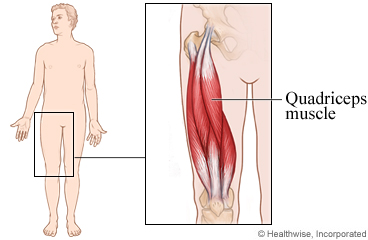Quadriceps Bruise: Care Instructions
Overview

The quadriceps is the big muscle that runs down the front of your thigh. Quadriceps bruises are often caused
by a fall or a direct blow to the thigh. They are common injuries in people who play contact sports.
A quadriceps bruise may cause pain and swelling in your thigh. It may hurt to use your leg or bend your knee.
You may have a red or black-and-blue area on your thigh.
To diagnose a quadriceps bruise, the doctor examines your thigh. You may also have tests to make sure you do
not have a more serious injury, such as a broken bone or nerve damage.
A quadriceps bruise will usually get better in a few weeks with rest and home care. Your doctor may recommend
physical therapy and exercises to stretch your leg muscles.
The doctor has checked you carefully, but problems can develop later. If you notice any problems or new
symptoms, get medical treatment right away.
Follow-up care is a key part of your treatment and safety. Be sure to make and go to all
appointments, and call your doctor if you are having problems. It's also a good idea to know your test results
and keep a list of the medicines you take.
How can you care for yourself at home?
-
Immediately after the injury, put ice or a cold pack on the injured area of your thigh for 20 minutes. Put
a thin cloth between the ice and your skin. While you apply ice, lie on your back. Bend your knee enough
that you can feel a gentle stretch in the front of your thigh. Try to bend your knee to about 90 degrees.
Use pillows to prop your bent leg up so you can relax in that position. Repeat the icing with your knee bent
every 2 hours for the first 48 to 72 hours.
-
Rest your injured leg. Don't put weight on it for a day or two. If your doctor advises you to, use
crutches to rest the leg.
-
Wrapping your thigh with an elastic bandage (such as an Ace wrap) will help decrease swelling. Don't wrap
it too tightly, though. A tight wrap can cause more swelling below the affected area.
-
Prop up your leg on a pillow anytime you sit or lie down during the next 3 days. Try to keep it above the
level of your heart. This will help reduce swelling.
-
Ask your doctor if you can take an over-the-counter pain medicine, such as acetaminophen (Tylenol),
ibuprofen (Advil, Motrin), or naproxen (Aleve). Be safe with medicines. Read and follow all instructions on
the label.
-
Don't do anything that makes the pain worse. Return to your usual level of activity slowly.
When should you call for help?
 Call your
doctor now or seek immediate medical care if:
Call your
doctor now or seek immediate medical care if:
Watch closely for changes in your health, and be sure to contact your doctor if:
Current as of: July 10, 2023
Content Version: 14.0
Care instructions adapted under license by your
healthcare professional. If you have questions about a medical condition or this instruction, always ask
your healthcare professional. Healthwise, Incorporated disclaims any warranty or liability for your use of
this information.